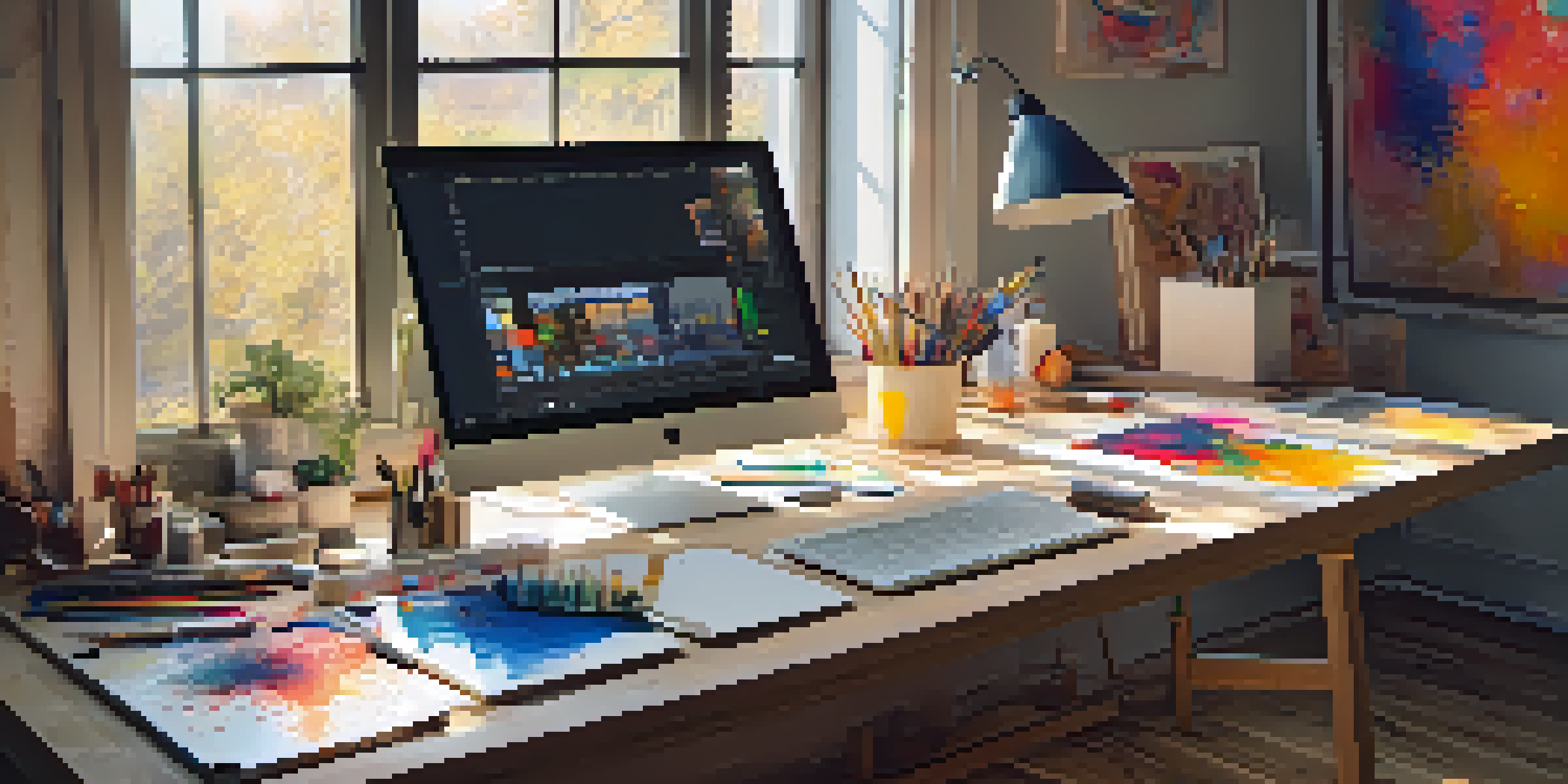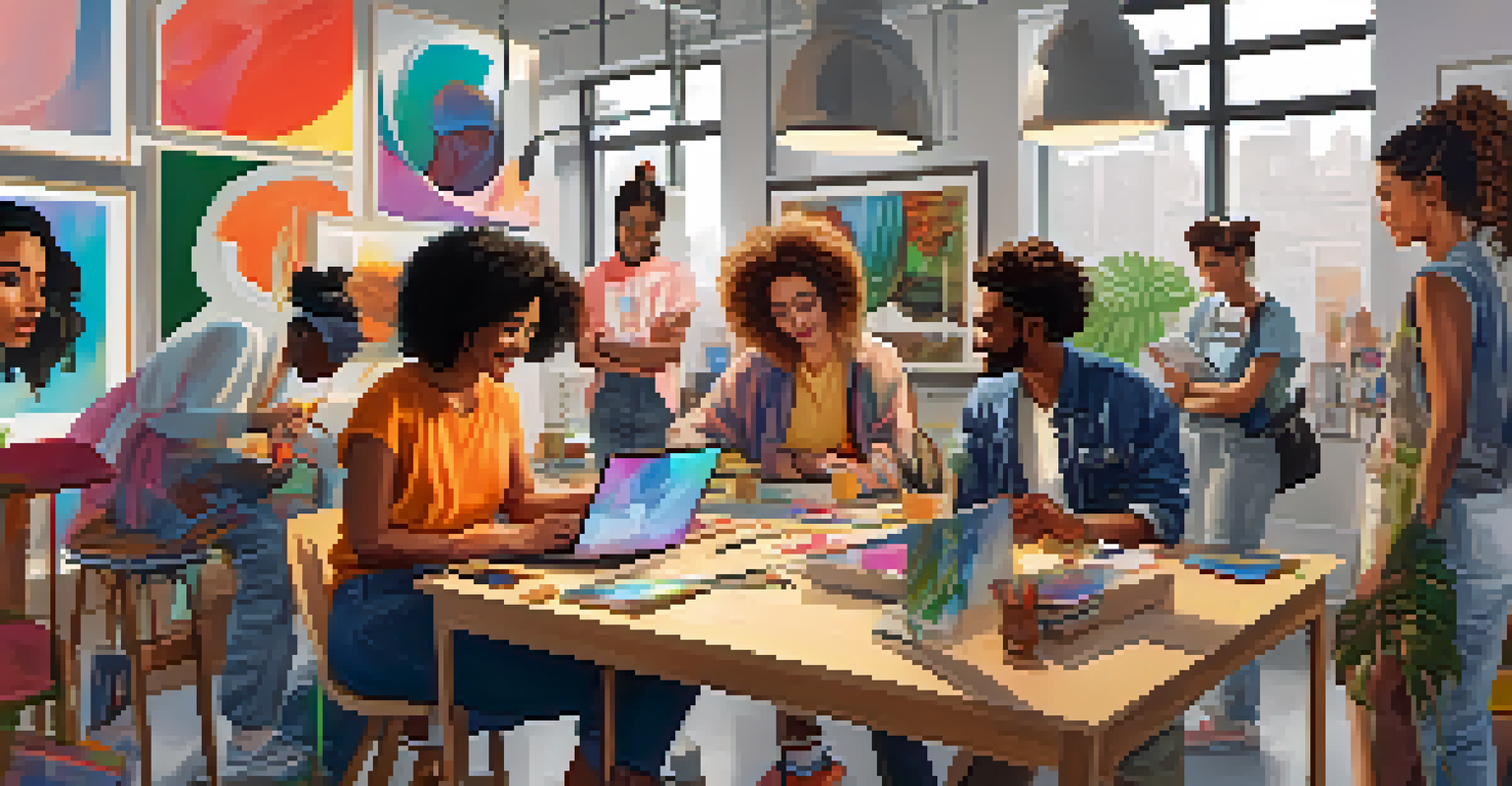The Impact of Technological Advancements on Artistic Practices

The Evolution of Art in the Digital Age
In recent years, art has undergone a significant transformation due to technological advancements. Artists now have access to tools that were unimaginable just a few decades ago, allowing them to create in innovative ways. Digital mediums, such as graphic design software and 3D modeling, have opened up new avenues for creativity.
Art is not freedom from discipline, but disciplined freedom.
This evolution means that traditional art forms are blending with modern techniques. For instance, some painters are incorporating digital tools into their workflows, using tablets to sketch before committing to canvas. This fusion of techniques not only enhances the creative process but also expands the possibilities for artistic expression.
Art is no longer confined to galleries; it has found a home in cyberspace. Online platforms allow artists to share their work globally, receive instant feedback, and even sell their creations. This accessibility is democratizing art, making it more inclusive and diverse.
The Role of Social Media in Artistic Exposure
Social media has become a powerful platform for artists to showcase their work and connect with audiences. Platforms like Instagram and TikTok allow for instant sharing, making it easier for artists to build a following and engage with their audience. This immediate interaction can inspire artists and influence their creative direction.

Moreover, social media enables artists to collaborate across borders, creating a global community of creators. Artists can share techniques and ideas, fostering a sense of camaraderie and collective growth. This interconnectedness is reshaping the way art is perceived and created.
Digital Tools Transform Art Creation
Artists are increasingly blending traditional techniques with digital tools, expanding their creative possibilities.
However, the pressure to maintain an online presence can also be overwhelming for some artists. The need for constant engagement may distract from the creative process, leading to burnout. Balancing online visibility with artistic integrity becomes a crucial challenge in this digital landscape.
Augmented Reality: A New Dimension of Engagement
Augmented reality (AR) is revolutionizing how audiences interact with art. By overlaying digital elements onto the physical world, AR creates immersive experiences that can captivate viewers in unprecedented ways. Imagine walking through a gallery where the art comes to life right before your eyes!
The only way to make sense out of change is to plunge into it, move with it, and join the dance.
Artists are harnessing AR to enhance storytelling within their work. For instance, a mural could reveal hidden animations or provide background information when viewed through a smartphone. This blend of physical and digital elements not only enriches the viewer's experience but also invites deeper engagement with the art.
As AR technology continues to evolve, its potential applications in art are limitless. From interactive installations to educational tools, the possibilities are exciting. This innovation encourages artists to think outside the box and explore new frontiers in their creative practices.
Artificial Intelligence: A Collaborator or Competitor?
Artificial intelligence (AI) is making waves in the art world, raising intriguing questions about creativity. Some artists are using AI tools to generate unique pieces, blending human intuition with machine precision. This collaboration can result in fascinating outcomes that challenge traditional notions of authorship.
However, the rise of AI also sparks debates about the nature of creativity itself. Can a machine truly create art, or does it merely mimic human styles? These discussions invite artists and audiences alike to reconsider what it means to be an artist in an age where technology plays such a significant role.
Social Media Connects Artists Globally
Platforms like Instagram and TikTok allow artists to share their work and engage with audiences, fostering a global community.
As AI continues to develop, it opens the door for new artistic possibilities. Artists can experiment with algorithms to create unexpected results and push the boundaries of their craft. The relationship between AI and art is an evolving narrative that reflects our changing understanding of creativity.
The Impact of Virtual Reality on Artistic Experience
Virtual reality (VR) is transforming the way we experience art, offering fully immersive environments that engage the senses. With VR headsets, viewers can step inside a painting or sculpture, exploring it from every angle. This immersive experience enhances emotional connections to the artwork.
Artists are leveraging VR to create entirely new worlds, inviting audiences to participate in their vision. For example, a VR installation might allow users to interact with digital sculptures, making them an integral part of the artwork. This shift from passive observation to active participation fosters a deeper appreciation for the creative process.
As VR technology becomes more accessible, its impact on the art community will likely expand. Artists are already experimenting with virtual exhibitions and galleries, reaching audiences who may never step foot in a physical space. This evolution represents a significant shift in how art is consumed and appreciated.
The Importance of Accessibility in Artistic Practices
As technology advances, accessibility in the arts is increasingly vital. Artists are using various digital tools to ensure that their work is available to a broader audience, including those with disabilities. This commitment to inclusivity enriches the artistic landscape and fosters a sense of community.
For instance, audio descriptions, captions, and tactile experiences can make art more approachable for individuals with visual or hearing impairments. By incorporating these elements, artists demonstrate a dedication to creating experiences that resonate with all audiences, not just a select few.
Emerging Tech Enhances Artistic Engagement
Technologies like AR and VR are creating immersive experiences that deepen audience interaction with art.
Moreover, technology enables artists to reach marginalized communities, amplifying diverse voices. Online platforms and virtual exhibitions allow artists from various backgrounds to share their stories and perspectives, enriching the tapestry of the art world.
Conclusion: Embracing Change in Artistic Endeavors
The impact of technological advancements on artistic practices is profound and multifaceted. As artists embrace new tools and platforms, they redefine creativity and challenge conventional boundaries. This dynamic interplay between technology and art invites ongoing exploration and innovation.
While challenges exist, such as the pressure of online visibility and the philosophical debates surrounding AI, the potential for growth and collaboration is immense. Artists are encouraged to harness technology not just as a tool but as a partner in their creative journey.

Ultimately, the future of art lies in its ability to adapt and evolve. By embracing technology, artists can continue to inspire, provoke thought, and foster connections in an ever-changing world.